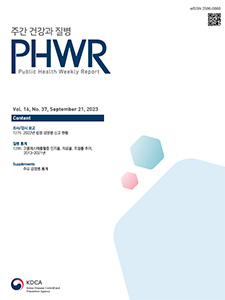Current Issue
Vol.16 No.37, September 21, 2023
-
Surveillance Reports 2023-09-21
 0
0
 1128
1128
 267
267
Status of Infectious Diseases Reporting in 2022
Jin Ha, Moonsun Choi, Daeun Yu, Noori Park
Public Health Weekly Report 2023; 16(37): 1275-1285 https://doi.org/10.56786/PHWR.2023.16.37.1 Abstract
AbstractOn June 30, 2023, Korea Disease Control and Prevention Agency released the 2022 Annual Report on the Notified Infectious Diseases, which summarized the status of notifiable infectious diseases reported in 2022. According to the Infectious Disease Prevention and Management Act and the Notification of the Types of Infectious Diseases Designated by the Korea Disease Control and Prevention Agency, there are a total of 89 types of infectious diseases. In 2022, 40 out of 66 infectious diseases subject to total monitoring were reported, while the other 26 were not reported. The number of reported cases of mandatory surveillance infectious diseases in 2022 was 28,517,466, up 4,759.7% from 669,478 in 2021. This followed a sharp increase in coronavirus disease 2019 (COVID-19), of which there were 92,861 cases in 2022, down 6.6% from 99,406 in 2021. The reported cases of major infectious diseases that increased compared to the previous year were those of COVID-19, dengue fever, malaria, and carbapenem-resistant Enterobacterales infections, while those that decreased were hepatitis A, hepatitis B, hepatitis C, chickenpox, and tuberculosis.
-
QuickStats 2023-09-21
 0
0
 634
634
 199
199
Awareness, Treatment, and Control of Hypercholesterolemia, 2013–2021
Public Health Weekly Report 2023; 16(37): 1286-1287 https://doi.org/10.56786/PHWR.2023.16.37.2

pp. 1433~1461
Most Keyword
?
What is Most Keyword?
- It is the most frequently used keyword in articles in this journal for the past two years.
Most Read
-
Waterborne and Foodborne Disease Outbreaks in the Republic of Korea, 2023
Myung-Jae Hwang, So Yeon Park, Hyungjun Kim, Se Jeong Yang, Sungchan Yang, Jin Seon Yang
Public Health Weekly Report 2025;18: 17-32 https://doi.org/10.56786/PHWR.2025.18.1.2 -
Implementation Plan for the Coronavirus Disease 2019 Vaccination for the 2024–2025 Season: Recommendations of the 6th Expert Committee on Immunization Practices
Hyewook Hwang, Wookeon Lee, Seohyeon Ahn, Young-Sook Choi, Seunghyun Lewis Kwon, Dongwoo Lee, Eun Hwa Choi, SokGoo Lee
Public Health Weekly Report 2025;18: 90-102 https://doi.org/10.56786/PHWR.2025.18.2.3
Editorial Office
+82-43-719-7569





 Full Text
Full Text Cite
Cite


